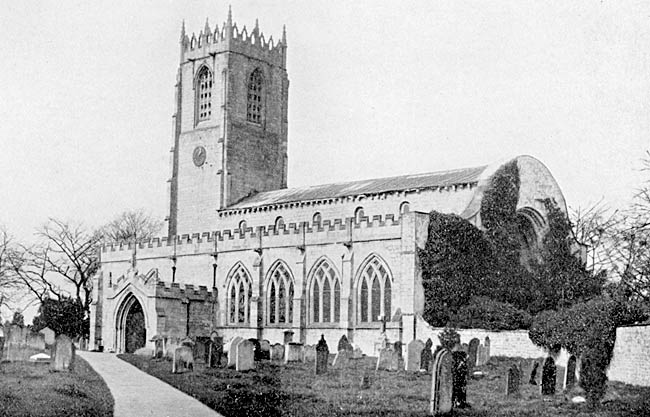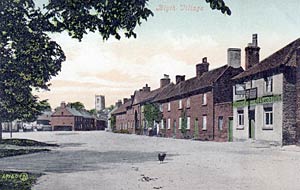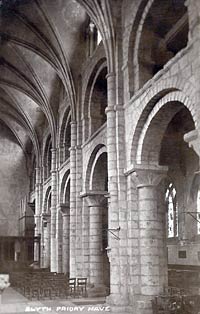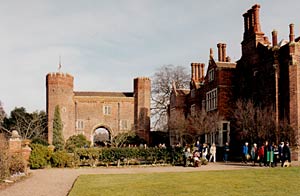< Previous | Contents | Next >
Village Charming

Blyth church, c.1900.
BLYTH. It is old and lovely, one of the most gracious villages in Notts. It has a road where the Danes came over a thousand years ago, a noble church with rare Norman remains, and a school with a doorway over 700 years old.

View along the High Street in Blyth, c.1905.
On the old highway from London to York, it was of great importance in early days, when it had a market, and fairs, and was close to bne of only five tournament grounds in England licensed by Richard the First. Now the wide road through the heart of the village is lined with trim houses, some of them clothed with creeper, some red-walled, others painted white, cream, and gold, and all red-roofed. On the long green island down the middle of the road is an elm plantation and a building with a roof resting on ancient beams, with mullioned windows in stone walls, and a beautiful 700-year-old doorway through which the children of Blyth go in for lessons and come out to play on the green shaded by three fine beeches. The building is said to have belonged to a Hospital of St John, founded for lepers in the 12th century; a farmhouse stands on the site of the hospital at the southern end of the village, and not far away is a row of six almshouses reminding us of the old charity.
The little River Ryton flows on three sides of the village, passing under the road near an old dovecot. From the three-arched bridge spanning it on the road to Maltby we see a delightful picture of the church and the great house, charmingly grouped with the river and noble trees.
The church is all that is left of the priory founded here in 1088 by Roger de Busli, as a cell of the Abbey of St Catherine at Rouen, but the strength and grandeur of what remains is eloquent of its magnificence. At the Reformation all the monastic part of the church was destroyed, as were the domestic buildings on the site where the hall now stands. The preservation of what is left is due to the fact that the nave and aisles served as the parish church, and it is in these that we see what is said to be the oldest example of Norman architecture in England in its style, though perhaps not actually in date. It is thought either that the plans used in the building of the Abbey of Jumieges in Normandy were borrowed for Blyth Priory, or that builders came over here for its construction. The abbey was built about forty years before the priory.

The Norman nave arcade at Blyth church, c.1920.
The pure work of very early Norman days, severe but majestic in its simple strength, is seen in the nave (with a splendid 13th century vaulted roof), the two arcades, the clerestory, the triforium on the south side, and the north aisle with its original vaulted roof. When this roof was moved to a lower level, the triforium openings on the north side had to be filled up, and 15th century windows were inserted under the round arches.
The arcades are of five bays with round arches on lofty pillars, and a sixth bay projects into the hall grounds. Among the heads enriching the capitals are two close together, perhaps representing Roger de Busli and his wife Muriel, who may be buried under two recesses in the outside north wall. The south aisle was enlarged to its present size in 1290, whence come its five windows, and seven gargoyles of ugly winged animals and a bird. The fine porch is also of this time.
The beautiful west tower, 100 feet high and a landmark, comes from the close of the 14th century. Eight pinnacles crown its charming parapet of open arcading; it has buttresses of seven stages, a canopied doorway, a west window with a niche on each side and another above it, and a great arch reaching to the nave roof.
The 17th century font has a bowl with cherubs, a base which may be Norman, and a Jacobean cover. The round bowl of a Norman font lies on the floor. The oak pulpit and a table are 17th century, an old almsbox is heavily banded with iron, and two quaint collecting boxes of 1661 are still used. The oak panelling on a wall of the chancel is part of the 17th century box-pews, as are the backs and ends of some benches. On the east wall are faint traces of 15th century paintings of Time, Judgment, and Eternity.
The east end of the south aisle forms the chancel, and has a beautiful 15th century oak screen with tracery and a vaulted loft. Six of the old paintings on the base panels are still clear, showing Stephen with stones, a woman slain with a sword, St Edmund crowned, St Helena, St Barbara with a lamp and a palm leaf, and St Ursula with eleven maidens. With the old work still left in the screen across the nave are eleven paintings of saints.
Lovely modern glass has a share in the glory of Blyth. In the five windows on the south side of the church are about 150 figures in Bible scenes. We see Samuel being taken to Eli, Moses found in the bulrushes, Joseph cast into the well, Abraham with Isaac carrying wood to the altar, the anointing of David, and scenes telling the story of Jesus. The beautiful west window of this aisle frames ten splendid figures.
Three ancient floorstones are carved with crosses. The battered knight wearing armour with a great shield and an unusual square-topped helmet was perhaps a Fitzwilliam of the time of Richard the First. On the projecting tomb of a big monument with a long inscription reclines the. short, stout, cross-legged figure of Edward Mcllish, who has been sleeping here since 1703. After making money in business in Portugal, he rebuilt Blyth Hall, which was enlarged during the next century and was wanting a tenant when we called.
 The 16th century brick gatehouse and 19th century house at Hodsck Priory in 1998.
The 16th century brick gatehouse and 19th century house at Hodsck Priory in 1998.Hodsock Priory (which never was a priory) stands at the end of a beautiful shaded lane two miles from Blyth. It is a modern house in lovely gardens, on the site of the old home of the Cressys and the Cliftons, and was the home of the Mellish family when we called. The moat is here still, its water crossed by a small stone bridge in front of the lovely Tudor gateway, which has 15th century windows and an embattled turret on each side of the archway.
